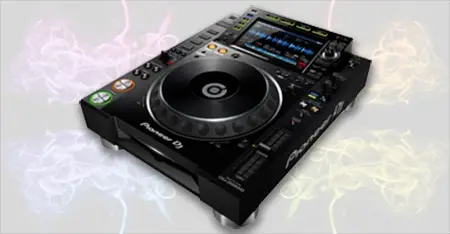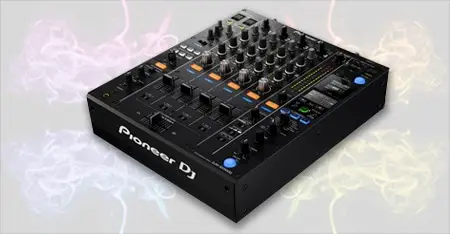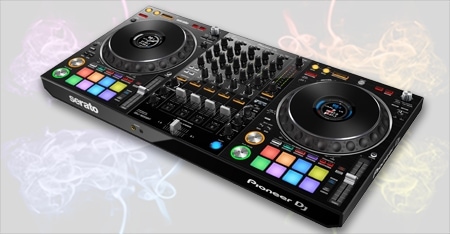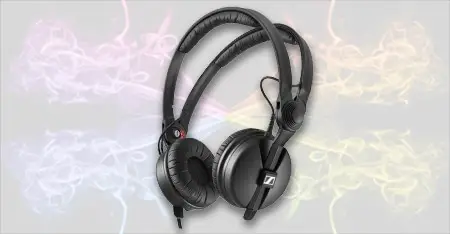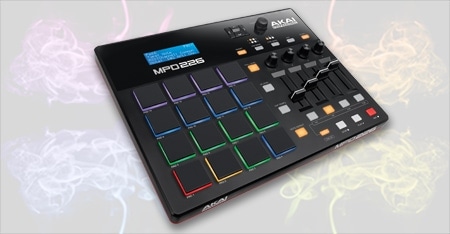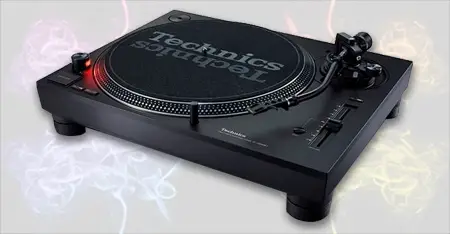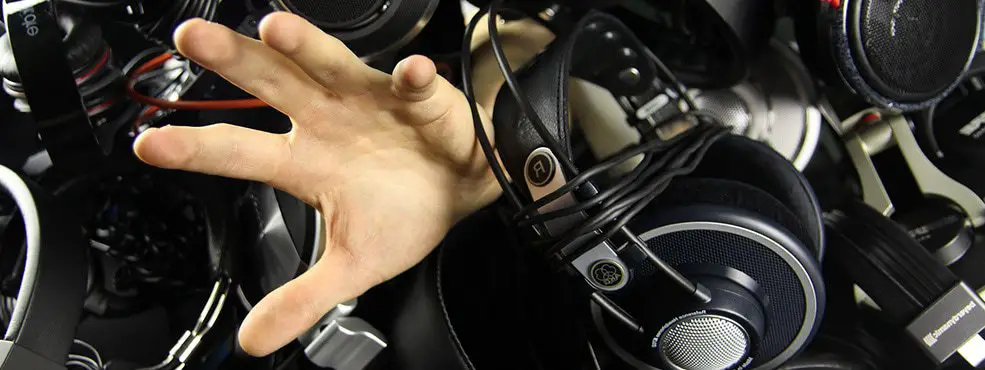
From functional to fashion accessory, headphones come in a variety of styles, shapes, and sizes. And each tends to serve a slightly different purpose. The biggest difference you’ll notice is in the type of headphones. So what do they mean and how do you compare on ear vs over ear vs in ear headphones? What are the benefits and what are the cons of each?
The arguments around types of headphones are varied. On ear headphones are more portable yet leak sound, over ear headphones don’t. However, they can be too chunky for touring DJs. Sound quality is also a factor, over ears generally win here but unless you plan to use them in the studio there is actually not much difference.
The headphones you require will be unique to you and the situation that you need them for. Once you know what type you’re interested in then you can start looking deeper into specifications and price points.
Of course, there are many factors and questions that go into deciding which headphones you want.
Such as:
- What are you mostly going to be using them for?
- How long will you be wearing them?
- Will you be traveling with them?
- Do you care how stylish they look?
So let’s dive in and give you an overview of the types of headphones.
To see my favourite headphones, head here.
Over Ear Headphones
Contents
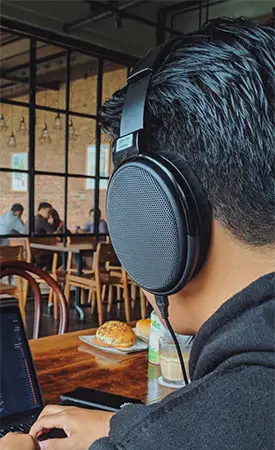
These are the headphones that you probably imagine when you think of people in studios doing recordings.
They are also known as Circumaural headphones, although chances are you won’t really see that name beyond articles like this.
Because over ear headphones tend to be used for specialists who do work like recording, DJing or editing, they are amongst the most comfortable of headphones to wear.
They are often fitted with extra padding and, due to their larger size, can have extra features such as noise cancellation and higher quality sound.
By definition, over ear headphones have large, well-padded cans that fully cover the ear and form a seal.
This makes them a comfortable fit while the seal improves sound quality by blocking out exterior noise.
Combined with larger drivers that channel more power into your ear means over ear headphones give you a much more immersive experience than other headphones.
If you are a true audiophile then chances are you’ll be going with over ear headphones.
Pros of Over Ear Headphones
- As mentioned above comfort, especially for long periods of wearing is one of the big advantages of over ear headphones.
- The abundance of padding then long DJ sets, editing or recording sessions shouldn’t result in any earache caused by headband pressure.
- Also, due to the large cans covering your whole ear means that background noise can be significantly deadened. This allows you to hear more clearly what’s going on in your headphones.
- You also often find over ear headphones with special features, for example:
- surround sound
- a larger sound stage or, as mentioned
- active noise-canceling. This is where the headphones actually monitor background noise and then produce opposite soundwaves to neutralize it.
- There are a couple of different versions of over ear headphones.
- Open back Sometimes the fact that they cover your whole ear can mean your ears get sweaty, however, that tends to be with closed-back headphones.
- closed back. Open back allows more air to get in and means that your ears will get less sweaty.
- Due to their larger size over ear headphones tend to be stronger in their build and their wire is also often durable. However this is, of course, dependent on the budget you spend on them, cheaper costs = cheaper build.
- When it comes to sound quality over ear headphones, particularly at the top end of the scale, are undoubtedly the best.
- over ear headphones can come in both
- Bluetooth versions
- Wired – Generally, when doing serious audio work you’re going to want to wire in, just to guarantee you are getting the full spectrum of audio.
So if you are doing any form of audio work that requires you to hear all frequencies clearly i.e bass, middle and treble then chances are you need over ear headphones.
To see a which over ear headphones I recommend, push here.
What Are the Cons of Over Ear Headphones
- The biggest con they have is their size and depending on the build quality, their weight
- So they’re not particularly good for day to day commuting for example out and about, although of course, you do see people wearing them in public.
- While some do also fold down they do still tend to be quite bulky when carrying them in a bag.
- As touched on briefly some over ear headphones, particularly cheaper models, can make your ears quite sweaty and this can make them uncomfortable to wear for long periods. Although higher-end models with breathable fabric do fare a lot better.
- After many months, sometimes years, of usage the ear pads can start to wear out. Although these generally can be replaced so it’s not the biggest issue.
- Due to their size and sound quality over ear headphones have historically tended to be the more expensive of the types of headphones. Although of course, these days headphones for all budget ranges are available. So you will be able to find over ear headphones however much you’re looking to spend too.
Sound Quality
When comparing on ear vs over ear headphones, over ear offer the best sound quality, hands down. This is in part because they cover your whole ear and block out exterior noise.
They’re larger size allows for larger drivers, which in turn means they’re able to reproduce audio more clearly and crisper.
One of the ways to define the sound quality of headphones is to talk about the “soundstage”. This means how wide the sound can be and what position you are within that sound.
Over ear headphones can create an expansive soundstage i.e a feeling that you are surrounded by music. You should feel you are in the middle of it with the music coming from both sides, depending on how the music has been mixed of course.
Again this does vary by manufacturer and how they have constructed/tuned the headphones.
Noise Cancellation
As they form a seal over your whole ear means they are quite good at naturally canceling out sounds. While things like the tightness of the headband clamp do play a factor, most over ear headphones do a fairly decent job of reducing background noise.
Even without having any form of active noise cancellation, which would cause your headphones to be more expensive.
When it comes to active noise cancellation then over ear headphones are by far the most effective. If you travel on planes regularly, for example, and you want to all but deaden the noise around you then it can be worth investing in a pair of decent over ear, active noise-canceling headphones.
Comfort
Most over ear headphones are extremely well padded to create a better seal around your ears as well as providing better comfort.
Their larger size can mean they are quite heavy. Again this depending on how much technology is included and the size of the drivers in the cans.
This is why the headband would also tend to be heavily padded. To counteract the weight and make them more comfortable to wear for extended periods.
Because they rely less on clamping to form this seal (like on ear headphones do) then they should cause less pressure stress to the ears. Aching should be minimal, even after long periods of wearing.
The drivers are also held off the ear, which can be a factor in causing headphones to be uncomfortable.
Again, high-end headphones that use better quality foam will be more comfortable and last longer than cheaper models. Although you can always replace or even upgrade ear pads. Sometimes the headband padding too, although this is slightly less common.
A lot of over ear headphones are fully adjustable. Usually in moving the cans up and down, adjusting the tightness of the clamp and the rotation of the cans.
Portability
The reason you’ll mainly see over ear headphones used in studios or at home is because of their large, bulky size. In this respect, they lose out in the on ear vs over vs in ear debate, as generally they won’t fit in your pocket and you need a bag to carry them.
Even if some do fold up, it’s best to use a case so as not to damage them while on the move. Particularly if you have invested in a decent pair.
So while you may use them for some journeys (I like using active noise-canceling ones on airplanes), you probably wouldn’t use them every day. On the bus to work for example.
Over the Ear Conclusion
Over ear headphones will give you the best sound quality of all types of headphones meaning they are perfectly suited to DJing. When comparing one ear vs over ear for studio work then the latter wins out everything.
They also tend to be the most comfortable and professional of all the types. Although this can be reflected in the price of course.
Not ideal for carrying day-to-day, unless you are regularly gigging and/or travel extensively and wants to block out as much noise as possible.
See a definitive list of the best DJ headphones here.
On Ear Headphones
These are the middle ground in the on ear vs over ear vs in ear discussion. They are ideal if you want portability, while still getting great sound quality. Sometimes called Supra-Aural headphones they are an alternative to the over ear type.
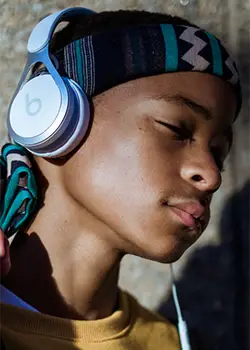
Arguably the most famous on ear headphones around at the moment would be Beats by Dre. Chances are, the image that comes to mind when you think of Beats headphones are the on ear version. Although they do studio versions as well.
As the name implies on ear headphones sit over your ear channels rather than covering the whole ear. Because of this, they tend to be a little bit smaller than their over ear counterparts.
This does let more background noise through, which is perhaps not a bad thing when you are out and about in public, crossing roads for example.
Due to their size (and so smaller drivers), they often have a reduced soundstage and less powerful bass. This is, of course, subject to build quality and tuning, which does vary by price.
Their size also affects their noise-canceling abilities. As they don’t cover the whole ear, they instead rely on clamping to form a seal. This is why the headband might be slightly tighter with on ear headphones than the larger, over ear type.
To make them more even more portable then there tends to be less padding on the headband and cans. Although this also varies by style and manufacturer.
Push here to see which on ear headphones I recommend.
The Pros of On Ear Headphones
- Definitely more compact when comparing on ear vs over ear headphones which makes them perfect for everyday use, even while out and about.
- Because they don’t form an entire see it on your ear people are still able to gain your attention and you should still hear some element of background noise.
- Of course, you do get active noise-canceling on ear headphones as well that will reduce background noise if you want them.
- The quality of sound does vary massively for him by manufacturer and cost, some high-end on ear headphones of her excellent depth of sound and clarity.
- As they don’t cover your whole ear and form a complete seal then they allow your ears to breathe. In this respect, they can be more comfortable to wear, if living in a hot country for example.
- Due to their smaller size and tendency to be stripped down of features also means they tend to be lighter. This again makes them comfortable to wear for long periods even when moving around or out & about.
The Cons of On Ear Headphones
- On ear headphones compensate for covering your whole ear by having a tight clamp. This is to try and form a seal over your ear canal. This pressure can, after extended wearing, cause aching in the ears.
- This can be made worse by minimal padding causing the drivers to actually sit on the rigid parts of your ear. Again, this pressure can make them uncomfortable and cause aching.
- While this clamping is good for keeping them on your head, they can become slippery when covered in sweat. Particularly if they have a plastic cover. Not ideal if you intend to use them for things like the gym.
- The durability of on ear headphones can vary massively, particularly as they are designed for portability. This is, in part, due to them folding up and being carried in bags, etc.
- Depending on build quality and cost, headphones can have weak points. This is generally when parts have made out of brittle plastic. Too much folding and carrying in bags can cause one side, or even the headband to snap.
- Wires getting stretched and forming loose connections can be another weak point. This can often cause one side to stop working, if not both. Again this does vary massively depending on price with higher ends built to be a lot more durable, of course.
- You can get active noise-canceling on ear headphones although they’re never going to perform as well when comparing on ear vs over ear. If you really do want to block out the outside world and need to do this often, then chances are you’ll want to fork out for proper over ear headphones.
- The drivers sitting on your ear, along with the pressure of the headband, means they tend not to be ideal for wearing for long sessions.
Sound Quality
Quality on ear headphones can deliver excellent clarity of audio as well as good frequency range and depth. Arguably they can never match up to over ear headphones and what their larger size makes them capable of.
However, if you invest in a decent pair of on ear headphones then you will definitely find them to have good quality sound. This is because the drivers are still large enough to produce rich and deep audio.
Advances in technology have also meant that build quality plays a larger factor in sound replication. Previously it was was very much down to the size of the driver alone.
DJs sometimes use on ear headphones (as they need to listen to both audio in the club as well as in their headphones). DJs choosing between on ear and over headphones comes down to personal preference.
Noise Cancellation
These offer the least natural noise cancellation when comparing the on ear vs over ear vs in ear types. This is because they don’t cover the entire ear, like over ears, or block your ear canal like in-ear headphones.
Higher-end models utilizing quality memory foam, reasonable clamp pressure and superior audio quality will do an excellent job of delivering you audio while significantly reducing background, ambient noise.
You can, of course, gets active noise-canceling headphones. They will do a better job of reducing background noise although, as these need to be powered, you will sacrifice a little bit of portability. This is because they need to house a battery pack to run the noise-canceling features.
Comfort
The comfort of on-air headphones is a bit of a trade-off. Being more lightweight makes them easier to wear for long periods. However, they can be prone to cause aching of the ears due to a general reduction in padding and increased headband clamp.
Really it depends on the length of time per day that you will be wearing headphones.
For example, if it’s just an hour or so while commuting then you probably won’t notice any pressure pain, and any headphones will be quite comfortable.
However, if you’re going to be doing ten-hour marathon gaming sessions then it’s a different story. While the weight won’t be an issue, the clamp pressure may start to give you a headache after a while.
In terms of ears overheating and sweating, this tends to be much less of a problem. Your ears can breathe more, particularly with high-quality covers on the ear pads.
Portability
On ear headphones are extremely portable for the sound quality that they can deliver. Models often fold down to make them easier to carry in bags or even fit in your pocket.
Of course, you’re never going to be as portable as in ear headphones. However, what you sacrifice in portability, you make up for in sound quality.
For example, if you love to actually feel bass then you would probably go for on ear headphones vs in ear. Particularly when you’re going to use them out and about in public.
As with any piece of expensive equipment you have invested in, it is worth taking care of your headphones.
If you plan on regularly keeping them in a bag then it can be an idea to get some that come with a hard carry case. Or buying a separate one for only a few more dollars.
Due to their focus on portability they can be prone to breaking however the better you treat your headphones the longer they will last you.
Head here for a definite comparison of different types of headphones.
On Ear Conclusions
Depending on your budget on ear headphones can be a perfect compromise. Providing excellent portability with rich and deep sound quality.
The decision comes down to how much where you are going to be using your headphones.
If you plan to use them regularly while walking or on public transport then you’re probably going to want to go with on-air headphones. This is assuming you’re not going to be wearing them for more than two or three hours a day.
If you will be wearing them for longer or are using them primarily at home then you may consider over ear headphones.
Noise-canceling and how much you want to block out the outside world also plays a factor. If you are out and about in a city then it’s not a bad idea to be able to hear environmental noise.
After all, if you’re crossing a road and don’t see a car then you want to be able to hear their horns. After all, not even perfect sound quality is worth sacrificing your life for.
Love DJ gear?
So do we, check out our favorites…
In Ear Headphones

Generally, everyone has a pair of in-ear headphones or earbuds as they are more commonly known. While you can’t beat them for portability, they vary massively in sound quality comfort and fit.
Definitely the most common type of headphones around, development has focused more on shaping them to fit within the ear. And then most recently the introduction of Bluetooth like with Apple’s AirPods for example.
Sound
The sound quality of in ear headphones very much depends on build quality and budget.
Their small size and tiny drivers are unable to produce the same depth of sound as their larger counterparts. That doesn’t mean they all sound bad though. High-end in ear headphones can still produce a reasonable sound quality.
Because they sit in your ear, blocking the canal then they actually do a pretty decent job of reducing background noise. This can help them sound better as it keeps the bass in and channels it directly into your ear.
Particularly well-designed earbuds, that fit the ear’s contours, are not only comfortable but actually turn the structure of your ear into a sound chamber.
Above we talked about how over ear headphones can produce vast, wide sounding soundstages. Earbuds, however, are unable to produce this same effect.
Because they drive the sound directly into your ears, then it sounds like the music is in your head. This is opposed to over ear headphones which makes the sound appear like it is around your head.
That said, there have been technological advances from specialized in ear manufacturers like Audeze’s iSINE series for example. These have produced a larger form of earbud that, as well as filling your ear canal, also forms a seal around your inner ear. This gives you an entirely different audio experience than most in ear headphones.
Push here to check their price on Amazon.
However you’ll pay for it, iSINEs run up into the hundreds of dollars. Quite a change from the plastic ones you can pick up from the two-dollar shop.
Comfort
The comfort of in-ear headphones is difficult to comment on given the variety of designs and manufacturers available. And that’s not even taking into account how different people’s ears are.
Earbuds have become better designed and more ergonomic in recent years. They used to be incredibly poor at actually staying put in your ears.
iPhone headphones are a great example of in ears that are designed to match the contours of your ear. More generic, cylindrical in-ear headphones often require to be pushed back into place every few minutes.
So, while they might necessarily not be uncomfortable or heavy they can be quite annoying to wear. This is where spending a little bit more on headphones can pay off.
While cheap ones will do the job they arguably won’t stay in place or create a proper seal, which reduces sound quality. Plus cheap headphones are also more likely to break.
Spending that little bit more should mean that effort has gone into the design and hopefully higher quality components. Given how much in ear headphones are wrapped up and stuffed in pockets then extra durability is a good idea.
If you’re willing to spend the money you can buy headphones that use memory foam. These mold to the shape of your ears much better than those made of hard plastic.
If you’ll be wearing them for hours and moving around then it is worth investing in some that fit the shape of your ear without needing to fiddle with them constantly.
Portability
Hands down, in ear headphones, are the most portable of all three types discussed here.
This is for obvious reasons. Given that they are simply a wire with a couple of buds on, they are very easy to wind up and put in your pocket or bag.
Although of course, this does make them susceptible to stress and breakage on the wiring.
Some do come with carrying cases or even automatic winders so you just push a button and the wires retract into a hard shell. Although from personal experience I haven’t found that this necessarily increases their durability.
Wires getting tangled are one common problem with in-ear headphones. Although sadly this will always be the case with wires. While you do get some higher-end models that have “anti-tangle” wires you’re never going to solve this problem completely.
Pros of In Ear Headphones
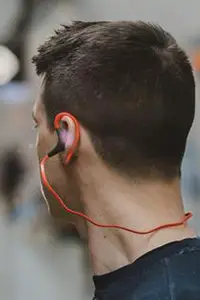
- Probably the biggest plus points of in ear headphones are the portability and the cost.
- If you use them primarily for things like audiobooks, where quality is less vital, you can get them cheaply and just throw them in your pockets when not in use. This makes them easy to replace if they break or you lose them.
- They’re very easy to hide. When I was in school and had long hair, I quite regularly had one earbud in and listened to music throughout the class. Definitely not something you could do with the other types of headphones.
- Your ears are not covered which means your ears can breathe. Assuming you get a fitted pair then they should hold their position and not fall out or need readjusting often.
- In-ear headphones can also be good if you’re planning to use them while working out in the gym. There are of course specific workout models. If this is where you’ll primarily be using them then they can be worth looking into.
Cons of In Ear Headphones
- Due to their small size in ear headphones are always going to be limited to the sound quality they can deliver. If audio quality is of prime necessity then you are always going to need to invest in over ear headphones. Even the top of the range in ear headphones are just not able to provide the full spectrum and depth of frequency.
- As mentioned above the fit of earbuds can be a problem, particularly if you don’t have average shaped ears. Because headphones are always designed around the most common ear types, they can fall out if they don’t fit yours perfectly.
In Ear Conclusion
In ears are by far the cheapest and most portable type of headphones available. If you’re always on the move, are forgetful and lose your headphones, or you’re not overly worried about sound quality, then they can be a great choice. They are very easy to just pick up cheap models and use them as you need to.
Due to their portability and being extremely lightweight, they can be good for using while working out or running.
However, if you do any serious audio work, like editing, studio work or DJing then in ear headphones are simply not going to cut it.
You will need something able to deliver a much richer depth of sound.
Check a full comparison of the best headphones on this page here.
Conclusion
The headphone style that you choose will very much depend on what you plan to use them for, where you plan to use them and what your budget is.
If you love sound quality and are often on the move then look at investing a pair of decent on ear headphones as they’re going to be fairly comfortable for extended periods.
If you spend a lot of time doing audio/studio work, or gaming, for example then look at getting some good over ear headphones. Be sure to focus on both sound quality and comfort when making your decision. If you invest that little extra getting more comfortable headphones then your recording or gaming sessions can last longer.
For those who are on the move all the time, value lightweight portability and need everything to be as compact as possible then look at getting a decent pair of fitted in ear headphones.
Of course, noise cancellation is available in every single type.
Noise Cancellation Conclusion
While noise cancellation is available in all types but will vary in effectiveness when comparing on ear vs over ear vs in ear.
If you fully want to block out the outside world then get yourself some over ear, active noise-canceling headphones.
If you travel a lot or plan to use them while sleeping on a plane, where portability is key, then get yourself some decent noise-canceling, in-ear headphones. As you can still wear these with your head down on a pillow for example.
Style Also Plays a Part
If you’re incredibly style-conscious, and this influences your purchasing decision, then you might want to focus your attention towards on ear headphones.
Due to their more stripped-down nature, designers tend to have a bit more freedom as there are fewer components to required. The downside of this is that they tend to be less adjustable of course.
However, there are some great-looking headphones out there that can be comfortable to wear and do provide great sound quality. As long as you’re willing to spend just a little bit to cover all bases.
A Final Word
Hopefully, now you understand what the three types of headphones are and the individual benefits that they have.
Know that you can choose whichever type suits you best. Be sure to compare individual brands and models to see which spec and price point suits you best and of course, meets your unique personal needs.
What next?
- If you have any questions about anything discussed in this post or have a favorite type of headphone, please drop them in the comments and I’ll reply to every single one.
- Looking for software to go with your headphones? Check out this guide that shows you Skrillex’s setup
- Looking for DJ tips now you’ve figured out headphones? Then this is the guide for you

